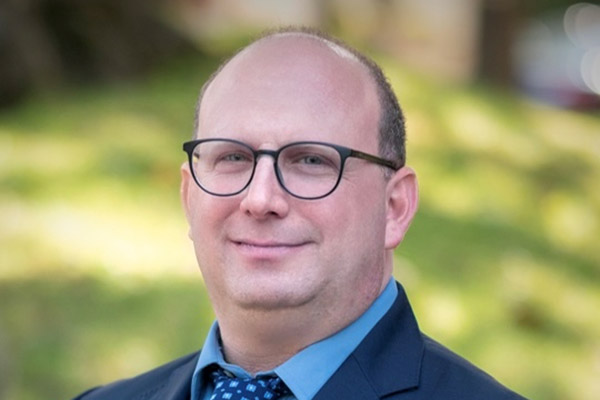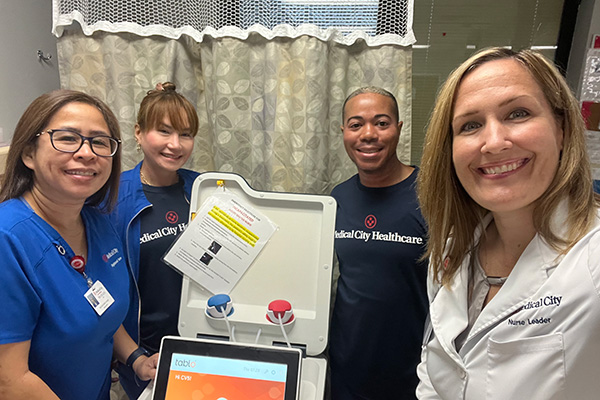Nephrologist Spotlight on David Henner, DO: Thinking Big with Home Dialysis

Summary
Dr. Henner is actively invested with his own patients and beyond in shifting the traditional in-center dialysis care mindset to “why wouldn’t this patient be a candidate for home?”
David Henner, DO, practices with a specific rule in mind at Berkshire Medical Center (BMC) in Pittsfield, MA, that has led to a powerful mindset change among his team: all ESRD patients are considered home dialysis candidates until proven otherwise. This approach emphasizes a whole-person strategy to treatment and care of chronic kidney disease, and self-management whenever feasible, as home dialysis is associated with better overall health, quality of life and survival than in-center care. What has allowed for this radical flip in the traditional chronic dialysis care model? In Henner’s view, it’s the impact of Tablo.
“In the hospital setting, we start the conversation about home with patients the second they begin dialysis—even before they hit the outpatient world,” he says. “We tell them that Tablo, specifically designed for patient-driven self-care, is potentially the machine that they can go home on. Our team’s discussion has shifted to ‘why wouldn’t this patient be a candidate for home?’, which is where we want to be in terms of changing the mindset and culture. We have patients now lining up to be trained to go home.”
“In the hospital setting, we start the conversation about home with patients the second they begin dialysis—even before they hit the outpatient world.”
Henner has served as Division Chief of Nephrology and Medical Director at Berkshire for the past 16 years, and is also the medical director and administrator of Dialysis at BMC South County Dialysis Center, BMC North County Dialysis Center, and Southwestern Vermont Medical Center’s Dialysis Center.
Berkshire partially converted their inpatient dialysis unit and ICU to a fleet of Tablo consoles in 2019, following Henner’s introduction to the system’s clinical capabilities, cost savings, and staff and patient benefits, at a clinic utilizing Tablo in-center the previous year. When Tablo was first implemented at Berkshire, approximately 25% of all inpatient treatments were performed using the system, but that number is now at about 75%. “Our staff is really appreciating the ease of use and functionality of Tablo versus our traditional machines, including wireless data management with TabloHub, and not needing a separate water treatment system. We’ve seen a big change in our workflow,” Henner says.
Home-First Initiative Backed by Clinical Evidence
Berkshire then launched its in-center outpatient program in early 2020, and Henner was one of the first nephrologists in the country to send dialysis patients home with Tablo following FDA clearance for that indication in April 2020. Today, Berkshire’s patient-focused models, including self-care and transitional care, further supported by the advantages of keeping these COVID-19-susceptible patients out of the in-center environment, are driving growth in its home program. (Note: Henner discussed Berkshire’s successful dialysis care model on a May 26 Modern Healthcare webinar entitled “Hitting the Reset Button – Achieving Cost Savings and Standardization in Dialysis,” that also included Ray Morales, Assistant VP for Kidney Services at Intermountain Healthcare.)
Henner’s home patients are all using Tablo and doing well, he says, due to the all-in-one system’s consumer product simplicity, fewer reported symptoms due to dialysis, schedule flexibility, wireless connectivity, compact size, minimal supply storage, and other features that reduce the overall complexity of care. Prior to Tablo, his home hemo patients were using NxStage, but they had begun dropping out and going back in-center. “This was mostly due to patient and caregiver burnout from having to treat 5 or 6 days a week to get adequate dialysis, vascular access issues, supply storage, the time and effort required to batch dialysate, the extensive training and troubleshooting involved, and other challenges,” he notes.
“The results seen with Tablo have made such a positive impact on our nursing staff including our home training nurses, and our nephrologists and patients, which is helping us move closer to our vision of sending the majority of patients home,” Henner continues.
“We have patients now lining up to be trained to go home.”
As noted in a clinical study by Henner that was recently published in Hemodialysis International (2021; 25:A1-A14), with data on four patients compiled from July to October 2020, Tablo is easy to use and takes less training time (38 hours over two weeks) than prior home dialysis devices. Additionally, all patients successfully achieved clearance goals (Kt/V of ≥ 2.0) in fewer average weekly treatments (3.7 times per week with Tablo versus 5 times per week with NxStage). Using Tablo also led to high (98.5%) treatment adherence and 100% treatment success. Patients and nurses in the study reported high satisfaction with training and rated Tablo easier to use than prior technology. (Henner is also a principal investigator in the ongoing Home With TablO outcoMEs [HOME] Registry, a prospective, multicenter, single-arm, post-market study to evaluate real-world clinical outcomes in ESRD patients receiving in-home dialysis on Tablo.)
Henner also offers advice to other providers who may be considering starting a transitional care and home program with Tablo. “Number one you have to make the clinical case about what is best for the patient, and get that buy-in on your vision from nephrologists and leadership. Do this from a patient-centered approach and ask, ‘if you or a family member were a patient, what would you want?’” he says. “Make the case that you would want them to treat from the comfort of their own home if feasible. It’s better for their overall health, enables them to fit dialysis around their lifestyle, the system is safe, effective, and easy to learn and use, it is wirelessly connected to their provider, they have a better ability to maintain employment, and much more.”
He also points to the substantial CMS incentives available to providers that support the move to home dialysis, including add-on bonuses for being part of the ESRD Treatment Choices (ETC) Model (that Berkshire is gladly a part of, Henner says) as well as the inclusion of capital-related assets in the ESRD PPS Transitional Add-on Payment Adjustment for New and Innovative Equipment and Supplies (TPNIES).
Thinking Big About Going Home: Henner’s New Role on the National Stage
Henner is also looking to help support a home dialysis culture-shift for appropriate patients on a much larger scale. This July, he takes the reins as President of the National Forum of ESRD Networks, a not-for-profit organization that has its roots in the establishment of the national Medicare ESRD Program in 1972. The Forum represents 18 geographically defined ESRD Network Organizations that are under contract to CMS and serve as liaisons between the federal government and ESRD service providers and renal disease-focused organizations, such as ASN and NKF, to educate and promote quality healthcare for patients in the U.S. Henner has been actively involved in the ESRD Network program as current ESRD Divisional Board Chair and former Medical Review Board Chair of Network 1 (IPRO ESRD Network of Network of New England), and has served in the National Forum of ESRD Networks on the Medical Advisory Council representing Network 1, and as Immediate Past Medical Advisory Council Chair. “One of the major current goals of the ESRD Networks is to grow the number of patients dialyzing at home on a regional and national scale,” says Henner.
“My ultimate goal is to not only improve the health of patients under my care as a nephrologist, but to think bigger,” he continues. “I look forward to helping lead the discussions with CMS, in particular the Division of Kidney Health, to help to improve the quality of care and quality of life of ESRD patients across the country.”

